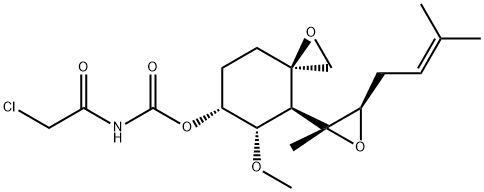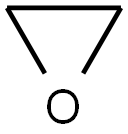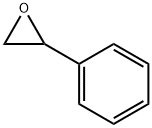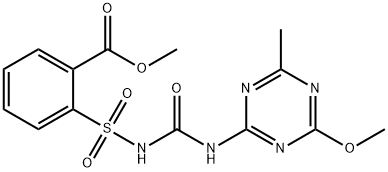AGM-1470
Synonym(s):(Chloracetyl) carbamic acid (3R,4S,5S,6R)-5-methoxy-4-[(2R,3R)-2-methyl-3-(3-methyl-2-butenyl)oxiranyl]-1-oxaspiro[2.5]oct-6-yl ester;, O-(Chloroacetyl-carbamoyl)fumagillol, AGM1470, MetAP-2 Inhibitor II, MetAP2 Inhibitor II, Methionine Aminopeptidase 2 Inhibitor II, TNP470;O-Chloracetyl-carbamoyl fumagillol;
- CAS NO.:129298-91-5
- Empirical Formula: C19H28ClNO6
- Molecular Weight: 401.88
- MDL number: MFCD00870281
- SAFETY DATA SHEET (SDS)
- Update Date: 2024-10-28 16:48:35

What is AGM-1470?
Description
TNP-470 is a synthetic analog of fumagillin that inhibits angiogenesis. It irreversibly inactivates methionine aminopeptidase-2 (MetAP2; IC50 = 2 μM), blocking endothelial cell proliferation in vitro and angiogenesis in vivo. It is without effect on MetAP1. TNP-470 has therapeutic potential in cancer and microsporidiosis.
The Uses of AGM-1470
TNP-470 is a synthetic analog of fumagillin that inhibits angiogenesis. It irreversibly inactivates methionine aminopeptidase-2 (MetAP2; IC50 = 2 μM), blocking endothelial cell proliferation in vitro and angiogenesis in vivo. It is without effect on MetAP1. TNP-470 has therapeutic potential in cancer and microsporidiosis.
The Uses of AGM-1470
TNP-470 is a synthetic analog of Fumagillin (F862650); a compound isolated from the fungus Aspergillus fumigatus. Fumagillin is an antimicrobial agent used in the treatment of microsporidiosis and shows promise as both an anti-infective and antiangiogenic agent.
What are the applications of Application
TNP 470 is an analog of Fumagillin that displays potent antiangiogenic activity and inhibits MetAP2
Definition
ChEBI: A carbamate ester that is fumagillol in which the hydroxy group has been converted to the corresponding N-(chloroacetyl)carbamate derivative.
General Description
TNP-470 is a synthetic analogue of fumagillin. It is a natural product of Aspergillus fumigatus. TNP-470 serves as an angiogenesis inhibitor.
Biological Activity
Analog of Fumagillin ((2E,4E,6E,8E)-Mono[(3R,4S,5S,6R)-5-methoxy-4-[(2R,3R)-2 -methyl-3-(3-methyl-2-butenyl)oxiranyl]-1-oxaspiro[2.5] oct-6-yl] 2,4,6,8-decatetraenedioic acid ester) that displays potent antiangiogenic activity in vitro and in vivo . Inhibits methionine aminopeptidase type II (MetAP2).
Biochem/physiol Actions
TNP-470 is a methionine aminopeptidase-2 (MetAP-2) inhibitor, selective for MetAP-2 over MetAP11. TNP-470 is an antiangiogenic.
in vitro
antitumor activity of tnp-470 was evaluated in eight human cultured cell lines derived from choriocarcinoma; ovarian cancer; tyk and nakajima; and uterine endometrial cancer. results showed that after 7-day culture with tnp-470, in medium at the concentration of 10 to 10-2 μg/ml, the inhibition of growth was observed in all of the eight cell lines. the half inhibitory concentration of choriocarcinoma cell lines was at an extremely low level compared to that of e uterine endometrial cancer and pithelial ovarian cancer [1].
in vivo
the anti-tumor effect of tnp-470 was studied using nude mice with tumors of gch-1(m), nuc-1, or nakajima cells. when the size of the transplanted tumor reached 100–200 mm3, 3, 10, or 30 mg/kg of tnp-470 was injected every other day. it was found that the inhibitory effect of tnp-470 was obtained by the administration of 10 and 30 mg/kg in gch-1(m) and nuc-1 cells, respectively, while in nakajima cells there was no significant effect. in addition, in nude mice treated with 30 mg/kg of tnp-470, lung metastasis of gch-1(m) cells was greatly inhibited both in the number and the size of tumor nodules, suggesting that the capillary growth in the originally developed tumor was also reduced [1].
References
[1] t. yanase, m. tamura, k. rujita, et al. inhibitory effect of angiogenesis inhibitor tnp-470 on tumor growth and metastasis of human cell lines in vitro and in vivo. cancer research 53(11), 2566-2570 (1993).
[2] c j logothetis et al. phase i trial of the angiogenesis inhibitor tnp-470 for progressive androgen-independent prostate cancer. clinical cancer research 7(5):1198-203.
Properties of AGM-1470
| Melting point: | 90-93°C |
| alpha | D24 -46.6° (c = 0.44 in CHCl3) |
| Density | 1.26±0.1 g/cm3(Predicted) |
| storage temp. | -20°C |
| solubility | DMSO: >15mg/mL |
| form | White to light yellow solid |
| pka | 7.19±0.46(Predicted) |
| color | White to Pale Yellow Waxy |
| Stability: | Hygroscopic |
Safety information for AGM-1470
| Signal word | Warning |
| Pictogram(s) |
 Exclamation Mark Irritant GHS07 |
| GHS Hazard Statements |
H315:Skin corrosion/irritation H319:Serious eye damage/eye irritation H335:Specific target organ toxicity, single exposure;Respiratory tract irritation |
| Precautionary Statement Codes |
P261:Avoid breathing dust/fume/gas/mist/vapours/spray. P305+P351+P338:IF IN EYES: Rinse cautiously with water for several minutes. Remove contact lenses, if present and easy to do. Continuerinsing. |
Computed Descriptors for AGM-1470
New Products
4-Fluorophenylacetic acid 4-Methylphenylacetic acid N-Boc-D-alaninol N-BOC-D/L-ALANINOL Tert-butyl bis(2-chloroethyl)carbamate 3-Morpholino-1-(4-nitrophenyl)-5,6-dihydropyridin- 2(1H)-one Furan-2,5-Dicarboxylic Acid Tropic acid S-2-CHLORO PROPIONIC ACID ETHYL ISOCYANOACETATE 2-Bromo-1,3-Bis(Dimethylamino)Trimethinium Hexafluorophosphate (6-METHYL-[1,3]DITHIOLO[4,5-b]QUINOXALIN-2-ONE INDAZOLE-3-CARBOXYLIC ACID 4-IODO BENZOIC ACID (2-Hydroxyphenyl)acetonitrile 4-Bromopyrazole 5,6-Dimethoxyindanone 2-(Cyanocyclohexyl)acetic acid 4-methoxy-3,5-dinitropyridine 2-aminopropyl benzoate hydrochloride 1-(4-(aminomethyl)benzyl)urea hydrochloride diethyl 2-(2-((tertbutoxycarbonyl)amino) ethyl)malonate tert-butyl 4- (ureidomethyl)benzylcarbamate Ethyl-2-chloro((4-methoxyphenyl)hydrazono)acetateRelated products of tetrahydrofuran








You may like
-
 TNP-470 CAS 129298-91-5View Details
TNP-470 CAS 129298-91-5View Details
129298-91-5 -
 2033-24-1 98%View Details
2033-24-1 98%View Details
2033-24-1 -
 1975-50-4 98%View Details
1975-50-4 98%View Details
1975-50-4 -
 2-HYDROXY BENZYL ALCOHOL 98%View Details
2-HYDROXY BENZYL ALCOHOL 98%View Details
90-01-7 -
 2-Chloro-1,3-Bis(Dimethylamino)Trimethinium Hexafluorophosphate 221615-75-4 98%View Details
2-Chloro-1,3-Bis(Dimethylamino)Trimethinium Hexafluorophosphate 221615-75-4 98%View Details
221615-75-4 -
 61397-56-6 CIS BROMO BENZOATE 98%View Details
61397-56-6 CIS BROMO BENZOATE 98%View Details
61397-56-6 -
 14714-50-2 (2-Hydroxyphenyl)acetonitrile 98+View Details
14714-50-2 (2-Hydroxyphenyl)acetonitrile 98+View Details
14714-50-2 -
 118753-70-1 98+View Details
118753-70-1 98+View Details
118753-70-1